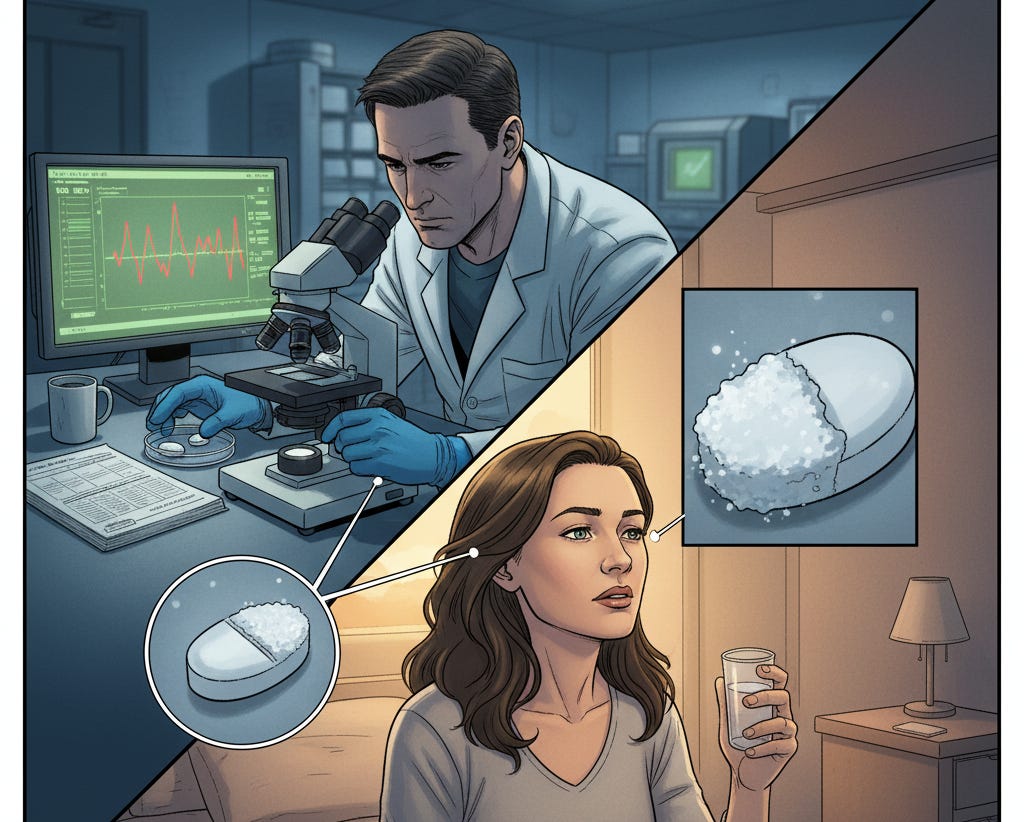The Peculiar Science of Manufacturing Investigations
The email landed in Blake’s inbox at 7:42 a.m., subject line in bold:
URGENT: Batch 7AQC – OOS Result.
His stomach tightened. Out-of-specification results never meant anything good. He pushed back from his desk in the manufacturing suite, shoved his safety glasses onto his nose, and made his way down the sterile hallways toward the quality control testing lab.
The air carried that familiar sharp tang of ethanol and compressed air, a smell that clung to every surface in the facility. The plant was a machine of its own—steel, glass, pressure differentials humming invisibly behind walls—and Blake was one of the many cogs meant to keep it running. His job wasn’t to invent miracles. His job was to protect them.
When he reached the QC lab, two analysts were already waiting by the HPLC station. Fatigue lined their faces; they’d probably run the same test three times to be sure.
“Blake,” said Priya, the lead analyst, “it’s the dissolution test. Twenty-two percent of tablets in the sample didn’t release the API within the specified time window.”
Blake leaned over the chromatogram, eyes scanning the jagged peaks. “Same method as always?”
“Same as always,” Priya said. “Calibration checks out. We re-ran everything twice.”
The failed batch sat in the adjacent room, two hundred thousand tablets of a cancer treatment that patients were waiting on. Each one had passed through compression, coating, packaging. Each one was supposed to dissolve inside the body at a predictable rate. Too slow, and the patient got too little. Too fast, and the dose could overwhelm. Either way, lives were at stake.
Blake nodded slowly. “Alright. Let’s start the investigation.”
Investigations in pharmaceutical manufacturing followed a familiar rhythm. First, contain the problem. Then, form hypotheses. Then, kill them off one by one with evidence until the truth was the only thing left standing.
Blake convened a meeting with the floor supervisor, process engineers, and Priya from QC. Around the conference table, everyone wore the same expressions of unease. A failed batch was money lost, but more than that, it was trust lost.
“We’ll treat this like a detective case,” Blake began, jotting on the whiteboard. “We need to think in terms of possible failure modes. Dissolution failure usually comes from: one, coating thickness; two, granulation uniformity; three, compression force issues; or four, an analytical anomaly.”
“Could be moisture uptake,” someone offered.
“Or a bad excipient lot,” another said.
Blake circled them all. “Good. Let’s test each hypothesis.”
They split up. Blake pulled process records, scouring them line by line. Machine logs showed no alarms. Environmental data was stable: humidity, temperature, differential pressures. Raw material certificates were clean.
He walked the floor, tracing the path of the tablets in his mind. Blenders. Compressors. Coaters. The machines hummed in steady rhythm, stainless steel arms churning powders into life-saving doses. He spoke with operators, not just ticking off procedural questions but listening. One remembered an unusual vibration in the coating pan. Another mentioned that the coating solution had seemed thicker than usual.
Back in his office, Blake stared at the mounting notes. Hypotheses eliminated: granulation, compression, excipient lot, analytical error. Still alive: coating.
The thought carried weight. If the coating was uneven, the tablets wouldn’t dissolve properly. He pulled the batch’s coating log. A single line caught his attention: spray rate adjustment due to nozzle clogging.
His pulse quickened. He pulled the coating samples from retain storage and held them under the microscope. Some tablets shimmered with a sheen twice as thick as the rest.
There it was. The culprit.
Blake presented his findings to management the next morning.
“The coating pan nozzle partially clogged,” he explained, clicking through slides of microscopic images. “That forced a manual adjustment, and some tablets got a double-thick coating. Those are the ones failing dissolution.”
“Can we salvage the batch?” the director asked.
“Yes,” Blake said. “But we’ll need to sort. We can run a weight uniformity screen. The over-coated tablets will stand out.”
The room buzzed with cautious relief. Two hundred thousand tablets were at stake. Rejecting the whole lot would mean months of wasted work and a hole in supply. Sorting offered a lifeline.
The next 48 hours blurred into long shifts of coordinated effort. Machines whirred as trays of tablets were weighed, measured, separated. Teams logged every detail. Blake walked the floor, keeping morale steady, reminding them of the stakes.
By the third day, the data was clear. The bad units had been identified and removed. The rest of the batch passed re-testing.
Blake allowed himself a deep breath. They had preserved not just the batch, but the patients’ trust in something they would never see, never question, but always depend on.
Weeks later, the batch had cleared distribution. Blake saw the pallets loaded into trucks, heading toward hospitals and pharmacies. He imagined the journey—through warehouses, into pill bottles, into trembling hands.
Thousands of cancer patients took their medication that month. Tablets dissolved in the quiet chemistry of stomachs and bloodstreams, exactly as they were meant to. Pain eased. Energy returned. Parents read bedtime stories. Students walked into classrooms. Lives continued.
And no one thought of clogged spray nozzles, or failed dissolution tests, or the long nights of weighing and sorting.
Blake thought of it, though. He thought of it every time he walked the sterile corridors of the plant. That was the work. That was the process. Invisible, exacting, necessary.


